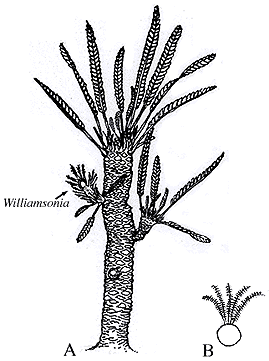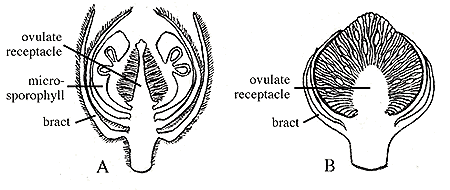The bennettitaleans (note informal name rather than the order-level Bennettitales) were originally mistaken for cycads because of their cycad-like growth form (Figure 10.9). However, the reproductive structures of these plants and syndetocheilic stomata place them soundly in the anthophyte clade.
Bennettitaleans first appear in the Triassic and became extinct toward the end of the Cretaceous. Two major groups are recognized: the cycadeoids with stout trunks and bisporangiate reproductive structures, and relatives of Williamsonia and Williamsoniella, which have slender, branching trunks and either bisporangiate or monosporangiate strobili.
Both groups had woody stems that were heavily armored with persistent leaf bases, much like modern cycads. Both produced entire simple leaves or pinnate foliage (VG 2:3), also like modern cycads. Indeed, the groups differ only in the details of stomatal morphology. This difference, when visible, permits unequivocal segregation of Mesozoic cycad and bennettitalean foliage, such as Nilssonia (VG 2:4). Note that this foliage form genus has also been linked to true cycads. Other foliage-types interpreted as benettitalean include , Anomozamites (VG 2:5) and Zamites (VG 2:6)
At one point, the bennettitaleans were put forward as possible flowering plant ancestors because of their flower-like bisexual reproductive structures (Figure 10.10). In Williamsoniella, for example, ovules alternate with interseminal scales on an ovulate receptacle at the center of several organ whorls (Figure 10.10a). This reminded some workers of the angiosperm carpel; to others, the complex alternation of interseminal scales and ovule-cupule seemed too derived to be the ancestral state of the angiosperm carpel. The next whorl out was occupied by microsporophylls bearing pollen sacs. This, in turn was surrounded by several whorls of bracts that many homologize with petals and sepals in flowering plants.




